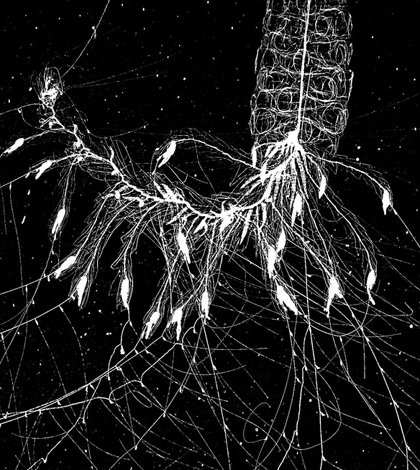Plankton Portal enlists public to classify thousands of zooplankton images

A zooplankton species image captured by the ISIIS of the coast of Southern California (Credit: Bob Cowen / University of Miami & Oregon State University)
Zooplankton drifts through the ocean, often ignored by the public in favor of more charismatic marine organisms farther up the food chain.
A new crowdsourced project aims to change that, giving anyone a closer look at small and intricate zooplankton. PlanktonPortal.org features 900,000 high resolution images of zooplankton and tasks the public to identify them as part of data processing for a collaborative study, based out of the University of Miami Rosenstiel School of Marine and Atmospheric Science.
Researchers hope the project will tell them more about zooplankton behavior, grouping and interaction.
It all started when a group from the University of Miami and BellaMare, an underwater instrument company specializing in plankton research, developed a new imaging system for zooplankton called the In Situ Ichthyoplankton Imaging System.
They wanted to add some context to zooplankton data by seeing the creatures in their natural habitat. “The idea was to collect images of plankton in a large volume of water, so we can image rare specimens,” said Cedric Guigand, a senior research associate at UM who helped develop the ISIIS instrument.
UM and BellaMare first developed a prototype benchtop optical imaging system, which shoots a beam of light into the water. When light waves hit an object of a different density than water, they bend differently than the rest of the beam creating a shadow of the object, which is recorded as an image.
Then the team translated the technology onto a towable, remotely operated vehicle that could image zooplankton in situ. They added water quality sensors to the imaging system to measure parameters like temperature, depth, dissolved oxygen, salinity, light and chlorophyll a.

Crew on board the NOAA R/V McArthur II retrieving ISIIS in the Gulf of Mexico, August 2011. (Credit: Jessica Luo / University of Miami)
Guigand said they successfully photographed zooplankton in 2010, with the imaging system undulating through the thermocline in the Southern California Bight.
They had to do something with the 900,000 images the ISIIS collected during the trip, but there were few feasible solutions to process them. It would take years to sort through the images manually and their automatic computer processing can only identify plankton based on shapes, leaving out detail.
During downtime on a research cruise in 2011, team members got to thinking while catching up on some research papers. They learned that an organization called Zooniverse specialized in facilitating crowdsourced data processing. The firm got its start in 2007 with a website that facilitated volunteer galaxy identification. Within a year, the public contributed more than 50 million galaxy classifications to the project.
The zooplankton imaging team led by Bob Cowen, formerly a UM emeritus professor of marine biology and now director of the Hatfield Marine Science Center of Oregon State, decided that it was worth a shot. They applied to work with Zooniverse and were accepted.

A screenshot of the Plankton Portal interface
Development was time intensive and required some crafty thinking to come up with a feasible and interactive site. The team decided to focus their identification on only a select group of gelatinous zooplankton. “You cannot look at everything,” Guigand said. “You would have hundreds of targets.”
The website opened to the public Sept. 17, after 18 months of development.
So far, almost 2,000 users have identified 150,000 specimens of zooplankton. “There is definitely a learning curve, but our users often get 100 percent right,” Luo said.
She said zooplankton are often underappreciated by the public but she thinks this project can help people recognize the importance and beauty of the small creatures. Guigand said he hopes the Plankton Portal can also show that science can be accessible to just about anyone, even those who fear number crunching and technical terms.
“These kind of crowdsourcing in science projects are really, really great in bridging the gap between the educational imperative and the outreach imperative that we have,” Luo said.




0 comments